Shower Curtain Sizes: Standards, Measuring, & More
Author: Omar Alonso | Editor: Omar Alonso
Review & Research: Jen Worst & Chris Miller

People spend thousands of dollars on bathroom renovations, often ending up with an overly expensive, hard-to-clean glass shower surround. The beauty of shower curtains over glass shower enclosures lies in their versatility. Shower curtains are easy to clean in the washer and come in hundreds of colors, fabrics, and design options. The trick with shower curtain sizes is finding the correct one.
Choosing the wrong size leads to ill-fitting curtains and potential water-dripping hazards. With these handy tips, anyone can find the right-fitting shower curtain size.
Industry Standard Shower Curtain Sizes
The shower curtain industry followed the lead of the bathtub and shower stall manufacturers to produce standardized sizing for shower curtains. There are a few variations on the market. It’s imperative to measure your tub or shower stall to ensure the curtains you order cover the space.
Most traditional bathtub sizes measure 60” across. This measurement comes from where the shower curtain rod fits across.
Shower curtains, however, usually come with an extra 12” flex material that stretches across the opening to prevent water from spraying out. The extra material folds in an attractive curtain style while fully enclosing the bathtub shower.
Industry-standard shower curtains come in several size options. The most popular and typical size is the 72” width x 72” length for classic style in-set bathtubs. This is probably what you expect and consider a normal size of shower curtain.
You'll also find curtains available in dimensions like these (width by height):
- 36” x 72”
- 72” x 72”
- 72” x 78”
- 72” x 84”
The 72” x 78” shower curtain size works best for walk-in showers with tall ceilings and opening heights. This matters because you need to reach the standard height for shower doors to keep the water inside. And how long is a shower curtain? In terms of standard shower curtain lengths, 72, 78, and 84 inches is what you'll find.
More material is not always best when choosing the right shower curtain size. If the shower curtain material is too wide for the opening space, the droplets on the curtain become trapped. This might lead to mildew problems. Choose the right size so that air can dry the curtain material sufficiently.
What Is the Right Shower Curtain Size for You?
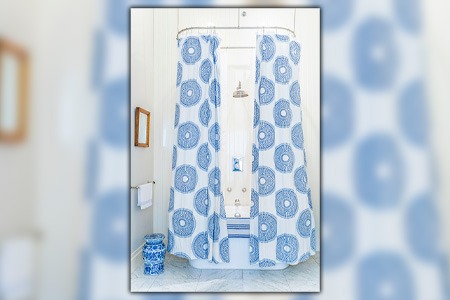
Most people buy whatever they see online or in the store; chances are they get it somewhat right. But anyone who’s ever dealt with an improper-fitting shower curtain can verify that it can lead to problems, even with shower curtain alternatives that need to be sized right.
Incorrect sizing might:
- Lead to shower curtains that won’t close properly
- Cause water pooling on the floor
- Results in water overspray onto walls and clothing
- Create soap and mildew build-up
- Look messy
Shower curtains are a great alternative to glass shower doors, only if they fit right. A sure way to know the correct fitting size is to measure before buying. Here’s the best way to get the right fit.
How To Measure a Shower Curtain Properly
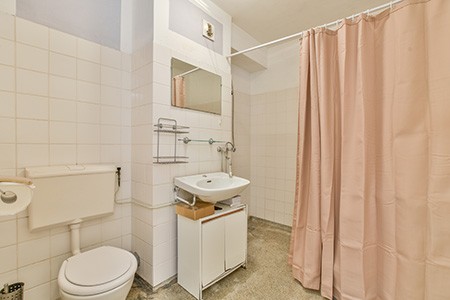
How are shower curtains measured? Armed with a retractable measuring tape, face your bathtub or shower stall opening. When measuring for a curtain, the width or long outside facing side makes the difference.
Measuring the Width or Opening
If the bathtub opening measures 60”, the shower curtain should be 72” wide. The extra 12” are to provide access to pull the curtain closed on both ends of the opening. The additional material will create a drape effect with lengthwise folds.
This extra material also prevents drafts from pulling the curtain open when someone enters the bathroom and allowing that dreaded cold air to enter. Anyone who showered with an improper-fitting shower curtain knows it becomes a battle. People often get soap in their eyes while awkwardly struggling to close the curtain. Or, worse, slip and fall, which occurs most often in people younger than 15 years old.
Measuring the Length or Height
The length or height is defined by the measurement from the curtain rod down to the floor. The curtain is easier to adjust because many shower curtain rods are mounted in such a way to be immovable. The standard length of a shower curtain should be 72 inches.
The correct length will help the curtain to drape properly without bunching on the bottom, where it can trap water. It can create a build-up of mold and soap scum and become a tripping hazard. And it just doesn't look as nice.
Measure the distance from the floor to where the curtain rod is naturally. This height measurement depends on your ceiling space which should be standard 8’ to 9’. For tall families, this is easily adjusted by ordering a slightly taller shower curtain and raising the rod.
Most shower curtains either hang from shower curtain hooks or come with pre-cut openings called grommets. Hooks or grommets might add one or two inches to the length. Unless the rod is permanently mounted, it’s easily adjusted by raising the rod to avoid dragging.
Tip: Invest in a quality tension rod. Or opt for mounted rods that slip in out of a holding cup.
Shower Curtain Measurements for Free-Standing Tubs
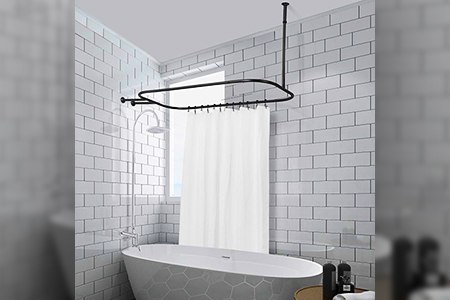
Nothing creates an ambiance like a free-standing bathtub in a bathroom. It evokes a romanticism until it’s time to shower without soaking the cat, the floor, and every towel.
Free-standing bathtubs require fixed shower curtain rods. These circular, oblong rods require mounting to the wall or ceiling. You won't be using any single, standard shower curtain sizes either.
The measurement from the floor to the rod has to be more specific since you can’t adjust the bar by raising or lowering it. Free-standing tub shower curtains typically use hook curtains since there’s no opening to feed grommet-style curtains onto the rod.
To measure the width, simply trace the outline of the tub with your measuring tape. For an accurate measurement, it’s best to have someone help. Measure the circumference and add between 12” to 24’ of extra material.
Showering in a free-standing tub is more challenging since you need to pull the shower curtain into the tub to create a surrounding barrier. Otherwise, the water will drip and pool onto the floor, which can cause slippery surfaces.
Tip: For free-standing tub shower curtains, consider buying two standard panels. Shopping for two curtains is easier than trying to find a unique size. Also, having two panels makes opening and closing the curtain easier.
Choosing the Right Shower Curtain Material
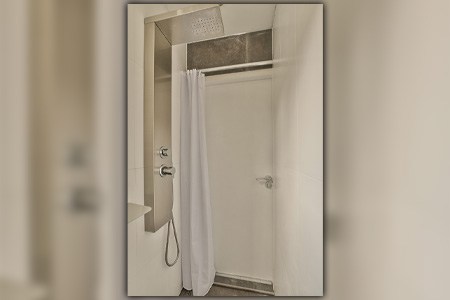
Shower curtains come in several textures and material options. Cheaper isn’t always less expensive in the long run if you have to replace them frequently. Using a shower curtain liner is always a good idea.
Choosing the right fabric that reflects your decor style is important. So is functionality. Nice quality shower curtains withstand the test of trends and wear and tear better than cheap plastic shower curtains.
Cloth-like shower curtains also wash well and won’t deteriorate with repeated cleaning. The best option is to invest in a quality shower curtain and a liner.
The liner is the same size as the decorative cloth curtain. Both will have the same shower curtain sizes, matching each other perfectly. It goes inside to prevent water spray. Typically made from plastic or vinyl, shower liners endure repeated washing, depending on the quality. Liners also protect the curtain from wear and tear.
When measuring to fit a shower curtain or liner, allow 5” to 6” of material to hang on the inside of the tub. A good material will stick to the tub and create a seal, while some include magnets to add weight and stick to tubs with metal inside.
How to Measure for Shower Stall Openings
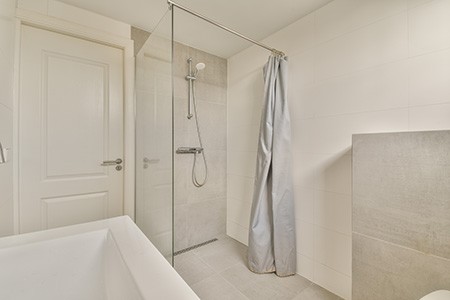
Custom shower stalls are slightly trickier than standard bathtub showers. Finding the right-fitting shower curtain is possible if you measure it correctly.
Shower stalls, stand-up showers, and walk-in showers come in many sizes. They often come with prefab doors or custom glass doors. Stall showers have a taller but narrower opening than traditional tub showers.
Measure the width of the opening and add 12” for excess material to prevent billowing from the water pressure or doors opening.
Most shower surrounds use standard-size curtains in 36” x 72, 50” x 78”, or 54” x 78”. For shower stalls, ensure you have enough material to cover the opening from top to bottom. The best fit has the curtain just gracing the base tile.
Adding weight to the curtain’s hem prevents it from lifting and creating overspray. Most attractive shower stall shower curtains come in many optional sizes. These optional sizes include:
- 60” x 70”
- 72” x 72”
- 72” x 78”
- 72” x 84”
- 72” x 96”
Remember that the measurements of the shower curtain will need to be about 12” wider than the opening of the stall or shower surround in order to sufficiently block water from splashing out.
Tip: With ingenuity, it is possible to cut and re-sew most shower curtains and liners to fit unusual-sized showers. Adding a bit of weight to the hem prevents it from lifting in drafts.
Extra Wide Shower Openings
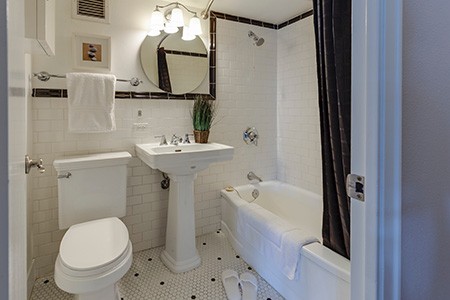
Extra wide shower openings or wet rooms are a great idea in concept. Wet tiles can become a hazard, so installing shower curtains is a good idea. Don't be afraid to have two curtains on one rod, overlapping or even clothes-pinned together.
Get an expandable tension shower curtain rod for extra wide shower openings to fit the space. Some come in sizes of min 54” - 90” max. There are other sizes, though, that include:
- 24”- 36”
- 36”- 54”
- 36”- 62”
- 42”- 72”
- 78”- 108”
Shower tension rods are a fantastic way to mount shower curtains without any tools or adhesive. They also make great places to hang wet towels in a small bathroom after you're done showering. Just open the curtain some and drape the towel over the rod.
Shower Curtain Sizes Made Simple
Finding the right shower curtain sizes is easy. Remember to measure across and add 12" of material to create the drape effect. Investing in good quality shower curtains transforms the most popular room in the house instantly and cost-effectively.



